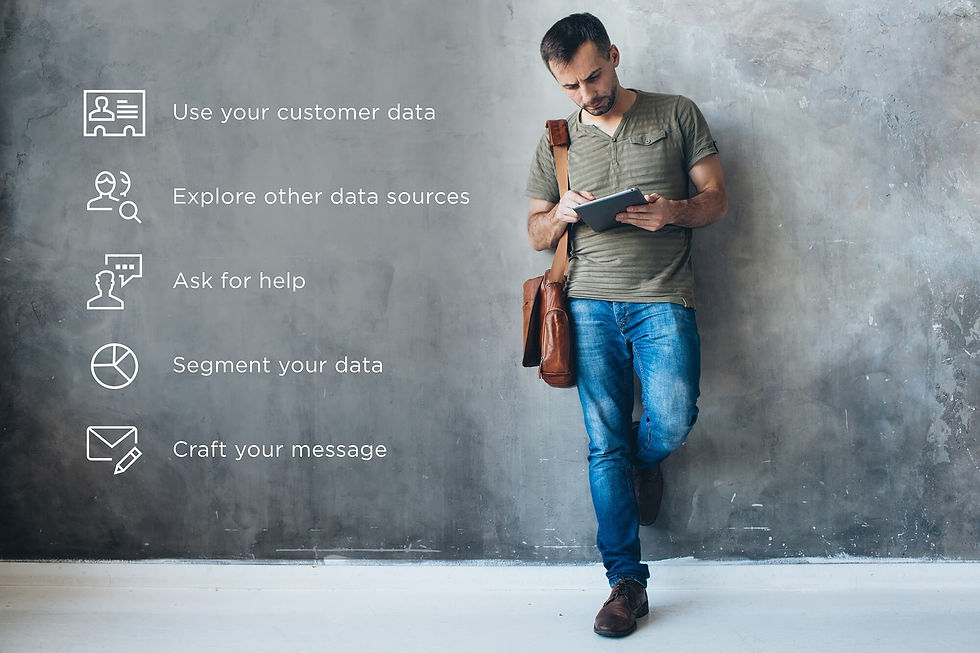
When you’re looking to maximize customer interactions, and engage in truly meaningful conversations, the devil is in the detail. So, it pays to get smart about segmentation. Here are a few ideas on how to segment your audience to create effective, customer-centric email marketing campaigns.
In digital marketing, no two customers are exactly the same. Which is why, when it comes to personalizing the message, we need to move beyond making general assumptions about buying decisions. This is a fairly obvious statement, but you only need to open your inbox to see how few organizations actually tailor engagements or personalize their content. Adding the correct name and salutation at the top of the email doesn’t count!
By carefully targeting your offer or message to different segments, you’ll see an instant uptick in campaign response rates. Because, the more relevant you are to each customer, the more motivated they’ll be to take the next step. All of which makes your marketing spend go further when it comes to generating returns.
The stats bear this out. A recent study by eConsultancy found 74% of marketers agreed that targeted personalization increases customer engagement. Similarly, a national survey by the UK’s Direct Marketing Association found segmented and targeted emails generated 58% of all revenue. Countless other surveys support this point. Ultimately though, at the core of every good marketer is the knowledge that the more they know, the more successful they are.
In short, success means saying goodbye to blanket emails that, more often than not, get deleted without being read. Which is easier said than done – especially when marketers are under pressure to get campaigns out, and leads in, as quickly as possible. And, of course, the data isn’t always readily available. Either way, it pays to step back and consider how best to segment your data (and audience) before you start crafting the message.
It all begins with data
It goes without saying that segmentation is driven by data – and there are an overwhelming number of ways to segment your list.
Starting with the basics is an important first step – segmenting by geographic location or demographics like age, gender, life stage, occupation, income, education or social status. Then it’s time to get sophisticated.
Targeting ‘music lovers’ may be a good idea for some. But ‘music’ isn’t a segment in any true (or useful) sense. Not all music lovers want to buy tickets to a Country and Western concert, for example. Or want to own a classical music album. Others may love R&B and hate Hip-Hop. And it’s not just musical genres. Breaking audiences down by age doesn’t always work well either. Not all 18-year-olds will be excited at the prospect of purchasing and downloading a Justin Bieber track!
Novartis Animal Health, a leader in developing new and better ways to prevent and treat diseases in pets, farm animals, and farmed fish, faced a similar challenge. ‘Pets’ isn’t a segment! So, when Novartis wanted to promote a new pet-care treatment to encourage recipients to sign up for the treatment at their local vet, the company needed to break it all down. By doing so, Novartis was able to achieve some 32,000 new customer registrations. Take a look at the case study here.
True segmentation (and personalization) brings together all kinds of data, from known (and predicted) customer interests, demographics and much more. Which is why many brands struggle to get it right.
The Novartis example, among many others, shows the true value of identifying additional contextual data – lifestyle, values, attitudes, activities, interests, opinions and concerns – which adds further rich personalization insights into the mix.
And then of course, there’s behavioral and/or derived data – past purchases, known price sensitivities, current user status or service lifecycle stage. And if it’s available, what about purchasing intent and digital or online behaviors?
The more sophisticated your segmentation, the better.
And why use email instead of the much-hyped social channels as the vehicle to drive your segmented messages? Simple: for every $1 spent, email marketing generates $38 in ROI.
Here are our top 5 tips on how to create highly targeted and personalized email campaigns:
Use your customer data– collect customer data at every point, from initial contact and throughout every engagement. Then mine the data to continually segment customers and refine your email campaign messages.
Explore other data sources– don’t just rely on customer-generated data from sign-up forms. Take a look at the full range of your customer’s activity – like click behaviors and their purchasing frequency. You’ll learn more about them from what they do, rather than depending on just what they tell you.
Ask for help– if you’re unsure about data capture or exploring data sources outside your customer database, it’s often a good idea to partner with an expert able to help. This will likely save you valuable time and money in the long run. Choose your marketing partner carefully so you are guaranteed a good return on your investment.
Segment your data, segment again– we said it before, and we’re saying it again. Advanced email segmentation campaigns make use of combined or derived data to go further and deepen every customer engagement – and that’s what you should be aiming for.
Get ready to craft your message– you’ve done all the hard work, and now you’re well positioned to craft the individual customer messages, based on your segmented criteria. Your deep knowledge of the personas means you can tailor everything from the subject line to the customer offer.

Final thought
Don’t forget the message. 21st century marketing may be driven by data, but all the insights in the world will be as nothing if the communication is uninspired and lacking impact, or there’s no follow-up. So, bring your campaign to life with creative ideas and images, and ensure you’ve put the analytics in place to monitor and evaluate how people respond – so you can further refine (and segment!) future campaigns.

.png)
Comments